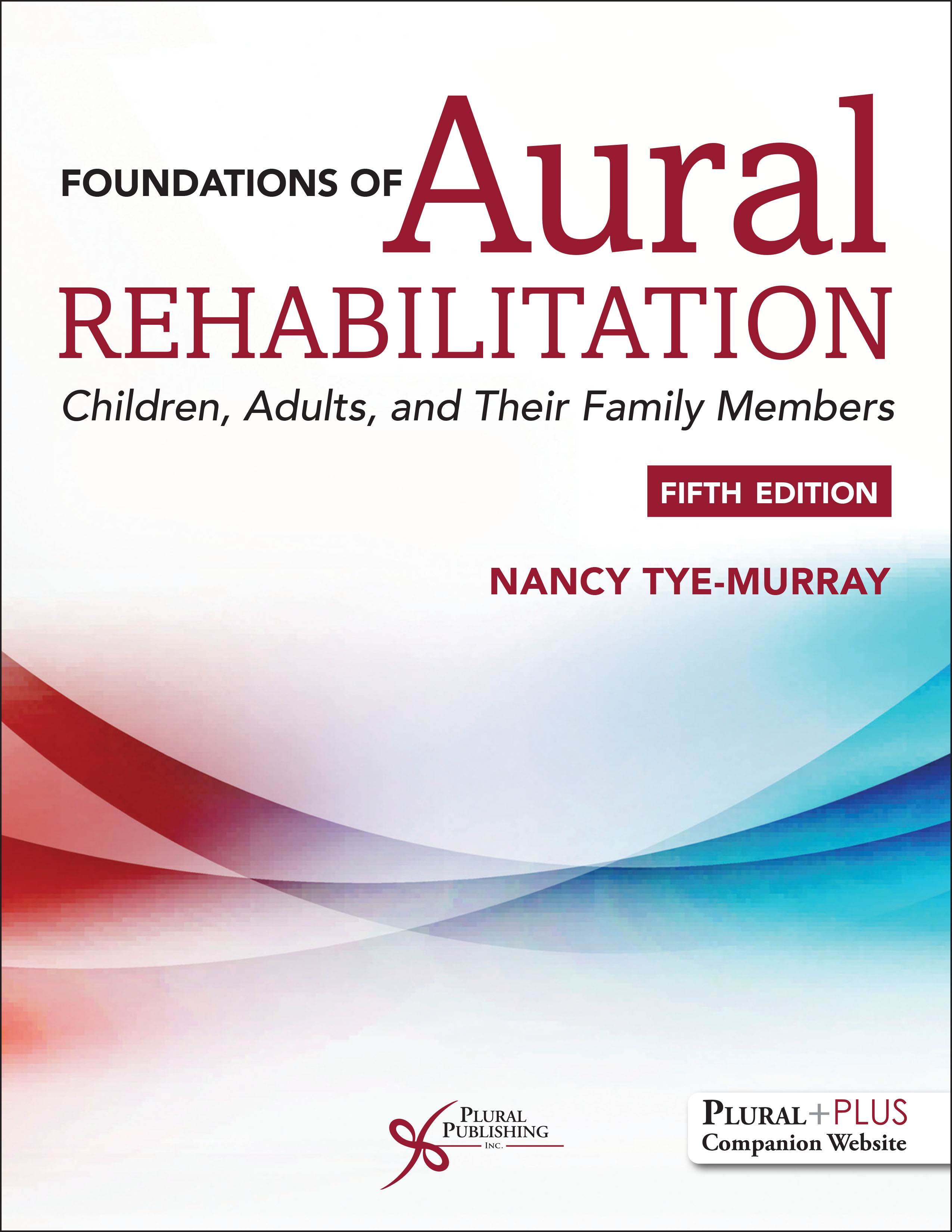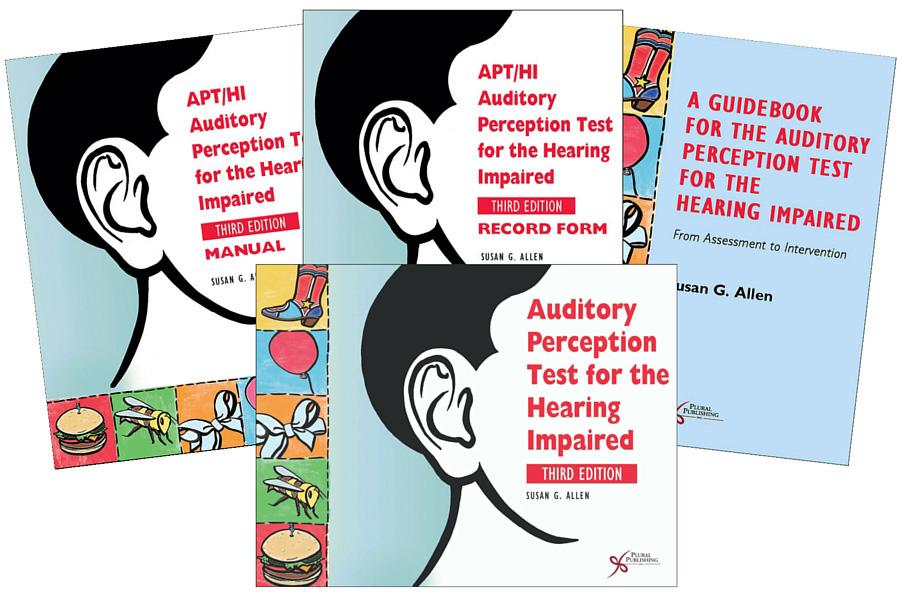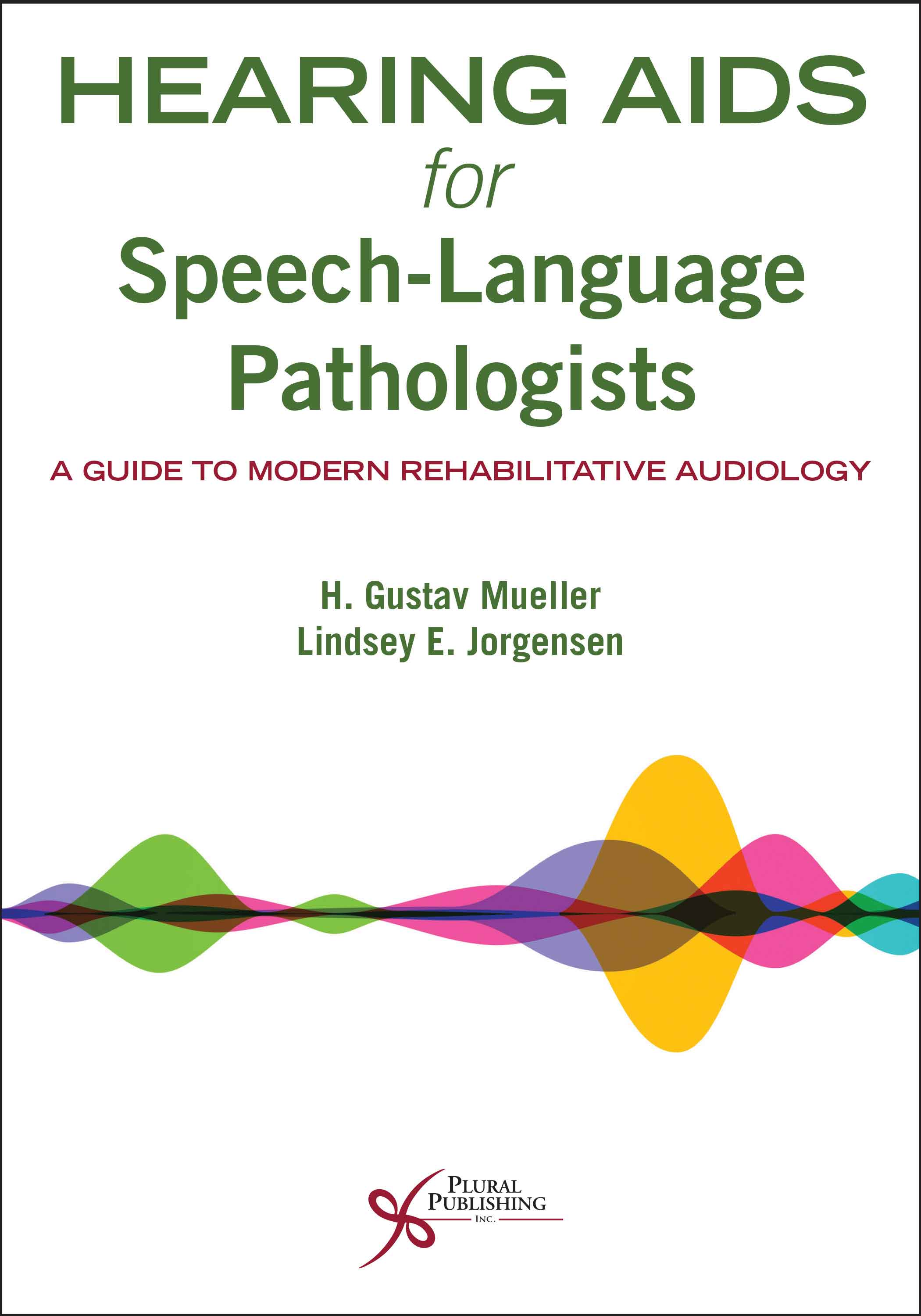
Foundations of Aural Rehabilitation: Children, Adults and Their Family Members.
Fifth Edition
Nancy Tye-Murray
Details: 553 pages, 2-Color, Softcover, 8.5" x 11"
ISBN13: 978-1-63550-073-8
© 2020 | Available
A new edition of this text is available.
The best-selling textbook, Foundations of Aural Rehabilitation: Adults, Children, and Their Families, Fifth Edition, introduces the fundamentals of audiologic rehabilitation and hearing-related speech-language pathology in an easy-to-read, concise resource for the field of communication sciences and disorders. The text offers creative coverage of theory, clinical practice, and research-based approaches for identifying, diagnosing, and treating hearing and communication-based disorders.
The text is separated into three sections for the most comprehensive coverage of each topic: Part 1 describes the components of an aural rehabilitation plan, Part 2 concerns adults and their family members, and Part 3 concerns children and their parents. Important topics throughout include patient-centered services, counseling, selection and fitting of listening devices, conversational fluency and communication strategies training, auditory training, speechreading, and language and speech acquisition.
New to the Fifth Edition
- Reorganization of chapters from two to three sections, to streamline the presentation of the material
- Expanded presentation of research designs and principles of evidence-based practice
- State-of-the-science review of the most current research in auditory training and audiovisual speech perception
- Updated information and references to reflect emerging trends in speech and language therapy, along with practical examples of lessons
- New larger 8.5" x 11" trim size allowing for better display of text and artwork
- Improved and expanded number of figures that illustrate and illuminate key concepts and ideas
Key Features
- Text is written by a nationally and internationally recognized expert in aural rehabilitation, who is an active researcher in the areas of auditory training, speechreading, and communication strategies, and who writes in an engaging and clear style
- Chapters begin with Chapter Outlines and end with Key Chapter Points and Terms and Concepts to Remember
- Numerous case studies, sidebars, and text boxes
- Bolded key terms in text with definitions in margins, and a comprehensive end-of-book glossary
- Access to a PluralPlus companion website with supplementary resources for instructors and students, including PowerPoint lecture slides, case studies, learning activities, teaching tips, exam review sheets, and practice quizzes
20Q: A Perfect Storm for Auditory Brain Training
Read Nancy Tye-Murray's interview with Gus Mueller from AudiologyOnline here.
Review
"Nancy Tye-Murray leaves no stone unturned in her fifth edition of Foundations of Aural Rehabilitation: Children, Adults and Their Family Members. The exhaustive but not exhausting content offers a three-dimensional insight into the process of (re)habilitation in the clinical setting with offerings to both the student and experienced clinician.
The entire length and breadth of topics under the rehab umbrella are pulled together and mercifully placed on its 550 pages in accessible paragraphs, tidy tables and bulleted points; reinforced with clear sidebar definitions, case studies, illustrations, diagrams and quotation boxes. [...] What feels really impressive is the comprehensiveness of chapters 4-15 and the resources it provides to be used in real-world situations. Planning a group rehabilitation service? The hour-by-hour programme of the St Louis Psychosocial Hearing Rehabilitation Workshop is detailed on pages 257-60. Counselling parents through a new diagnosis? The stages of grief and tips for supporting them through each stage is set out on pages 360-1, along with cultural considerations later on in the chapter. Not discussing advanced technology with your older patients assuming they’re tech-phobic? There’s a box on page 309 with statistics that will prove otherwise (did you know that baby boomers spend more time online than millennials by 2:1?)
If you’re looking for a great resource to guide your future or current clinical practice, this book is certainly well worth the investment."
—Emilee Gosnell, Specialist Audiologist, in ENT & Audiology News (November 2020)
Preface
Chapter 1. Introduction
The World Health Organization (WHO) and Hearing-Related Disability
Services Included in the Aural Rehabilitation Plan
Where Does Aural Rehabilitation Occur?
Who Provides Aural Rehabilitation?
Hearing Loss
Service Needs
Cost-Effectiveness and Costs
Evidence-Based Practice
Case Study: Applying the WHOs International Classification of Functioning, Disability and Health
Case Study: Evidence-Based Practice Decision Making
Final Remarks
Key Chapter Points
Terms and Concepts to Remember
Appendix 1-1
Appendix 1-2
Appendix 1-3
Part One: The Components of the Aural Rehabilitation Plan
Chapter 2. Assessing Hearing Acuity and Speech Recognition
Review of the Audiological Examination and the Audiogram
Purpose of Speech Recognition Testing
Patient Variables
Stimuli Units
Test Procedures
Difficulties Associated with Speech Recognition Assessment
Multicultural Issues
Case Study: Reasons to Go with a Test-Battery Approach
Final Remarks
Key Chapter Points
Terms and Concepts to Remember
Key Resources
Chapter 3. Listening Devices and Related Technology
Hearing Aids
Cochlear Implants
Hearing Assistive Technology Systems (HATS) and Assistive Listening Devices (ALDs)
Computer-Based Technology
Case Study: Audio Technology
Case Study: Listen to the Music
Final Remarks
Key Chapter Points
Terms and Concepts to Remember
Chapter 4. Auditory-Only Speech Perception and Auditory Training
Historical Notes
Listening to Speech with a Hearing Loss
Candidacy for Auditory Training
Brain Plasticity and Auditory Training
Theoretical Underpinnings for Auditory Training
Auditory Training to Improve Speech Recognition
Auditory Training to Improve Music Perception
Benefits of Auditory Training
Case Study: Learning to Hear Again
Final Remarks
Key Chapter Points
Terms and Concepts to Remember
Chapter 5. Audiovisual Speech Perception and Speechreading Training
Speechreading for Communication
Characteristics of a Good Lipreader
What Happens When Someone Lipreads?
The Difficulty of the Lipreading Task
What Happens When Someone Speechreads?
Importance of Residual Hearing
Factors that Affect the Speechreading Process
Assessing Vision-Only and Audiovisual Speech Recognition
Traditional Methods of Speechreading Training
Speechreading Training Today
Efficacy of Speechreading Training
Oral Interpreters
Case Study: An Exceptional Lipreader
Final Remarks
Key Chapter Points
Terms and Concepts to Remember
Chapter 6. Communication Strategies and Conversational Styles
Conversation
Facilitative Communication Strategies
Repair Strategies
Stages of Communication Breakdown
Research Related to Repair Strategy Usage and Communication Breakdowns
Conversational Styles and Behaviors
Case Study: A Couple Conversing
Final Remarks
Key Chapter Points
Terms and Concepts to Remember
Chapter 7. Assessment of Conversational Fluency and Communication Difficulties
Conversational Fluency
General Considerations for Evaluating Conversational Fluency and Hearing-Related Disability
Interviews
Questionnaires
Daily Logs
Group Discussion
Structured Communication Interactions
Unstructured Communication Interactions
The Significant Other
Case Study: He Says, She Says
Final Remarks
Key Chapter Points
Terms and Concepts to Remember
Chapter 8. Communication Strategies Training
Self-Efficacy
Issues to Consider When Developing a Training Program
Getting Started
Model for Training
Short-Term Training
Communication Strategies Training for Frequent Communication Partners
Program Evaluation
Benefits of Training
Case Study: Patients with an Increased Sense of Self-Efficacy
Final Remarks
Key Chapter Points
Terms and Concepts to Remember
Key Resources
Chapter 9. Counseling, Psychosocial Support, and Assertiveness Training
Who Provides Counseling, Psychosocial Support, and Assertiveness Training?
The Patients Story and Narrative Therapy
Counseling
Psychosocial Support
Assertiveness Training
Related Research
Case Study: Solving Challenging Situations
Final Remarks
Key Chapter Points
Terms and Concepts to Remember
Key Resources
Part Two: Aural Rehabilitation for Adults
Chapter 10. Aural Rehabilitation Plans for Adults
Prevalence of Hearing Loss Among Adults
Characteristics of Adult-Onset Hearing Loss
Who is This Person?
Where is the Patient in the Journey?
A Patient-Centered Approach
The Aural Rehabilitation Plan
Case Study: A Road Map for Success
Final Remarks
Key Chapter Points
Terms and Concepts to Remember
Key Resources
Appendix 10-1
Chapter 11. Aural Rehabilitation Plans for Older Adults
Activity Limitations and Participation Restrictions
Audiological Status and Otologic Health
Life-Situation Factors
Physical and Cognitive Variables
The Effects of Untreated Hearing Loss
Aural Rehabilitation Intervention
Third-Party Disability
Aural Rehabilitation in the Institutional Setting
Case Study: Staying Active
Final Remarks
Key Chapter Points
Terms and Concepts to Remember
Key Resources
Appendix 11-1
Part Three: Aural Rehabilitation for Children
Chapter 12. Detection and Confirmation of Hearing Loss in Children
Detection of Hearing Loss
Confirmation of Hearing Loss
Health Care Follow-Up
Parent Counseling
Case Study: A Memorable Journey
Final Remarks
Key Chapter Points
Terms and Concepts to Remember
Key Resources
Appendix 12-1
Appendix 12-2
Chapter 13. Infants and Toddlers
Legislation Concerning Children Who Have Hearing Loss
The Individualized Family Service Plan (IFSP)
Communication Mode
Listening Device
Early-Intervention Programs
Parental Support
Auditory Training for Infants and Toddlers
Case Study: A Mothers Karma
Final Remarks
Key Chapter Points
Terms and Concepts to Remember
Appendix 13-1
Appendix 13-2
Chapter 14. School-Age Children
The Beginnings of Education for Children Who Are Deaf and Hard of Hearing in the New World
Creation of An Individual(ized) Education Plan (IEP)
The Multidisciplinary Team
School and Classroom Placement
Amplification and Assistive Listening Devices
Classroom Acoustics
Other Services
Children Who Have Mild or Moderate Hearing Loss or Unilateral Hearing Loss
Case Study: IDEA(S) for All Children
Final Remarks
Key Chapter Points
Terms and Concepts to Remember
Key Resources
Appendix 14-1
Chapter 15. Speech, Language, and Literacy
Speech Characteristics
Language Characteristics
Literacy Characteristics
Speech and Language Evaluation
Literacy Evaluation
Speech and Language Therapy
Case Study: Writing Samples from 10- and 11-Year-Old Children
Final Remarks
Key Chapter Points
Terms and Concepts to Remember
Glossary
References
Index
Purchasers of this book receive complimentary access to supplementary materials hosted on a PluralPlus companion website.
To access the materials, log in to the website using the URL located inside the front cover of your copy of Foundations of Aural Rehabilitation: Adults, Children, and Their Families, Fifth Edition.
STUDENTS:
To access the student materials, you must register on the companion website and log in using the access code located inside the front cover of your textbook.
INSTRUCTORS:
To access the instructor materials, you must contact Plural Publishing, Inc. to be verified as an instructor and receive your access code.
Email: instructormaterials@pluralpublishing.com
Tel: 866-758-7251 (toll free) or 858-492-1555

Comprehensive Dictionary of Audiology: Illustrated
Third Edition
Brad A. Stach
Details: 349 pages, B&W, Softcover, 7" x 10"
ISBN13: 978-1-94488-389-8
© 2019 | Available

Pediatric Amplification: Enhancing Auditory Access
First Edition
Ryan W. McCreery, Elizabeth A. Walker
Details: 272 pages, B&W, Softcover, 8.5" x 11"
ISBN13: 978-1-59756-992-7
© 2017 | Available

Auditory-Verbal Therapy: For Young Children with Hearing Loss and Their Families, and the Practitioners Who Guide Them
First Edition
Warren Estabrooks, Karen MacIver-Lux, Ellen A. Rhoades
Details: 602 pages, B&W, Hardcover, 7" x 10"
ISBN13: 978-1-59756-888-3
© 2016 | Available

Auditory Perception Test for the Hearing Impaired (APT/HI)
Third Edition
Susan G. Allen
Details: Full Color, Spiral-Bound Test Book, 8.5" x 11", plus Guidebook and Companion website with supplementary materials
ISBN13: 978-1-59756-590-5
© 2016 | Available

Telepractice in Audiology
First Edition
Emma Rushbrooke, K. Todd Houston
Details: 284 pages, B&W, Softcover, 6" x 9"
ISBN13: 978-1-59756-613-1
© 2016 | Available

Assessing Listening and Spoken Language in Children with Hearing Loss
First Edition
Tamala S. Bradham, K. Todd Houston
Details: 496 pages, B&W, Softcover, 7" x 10"
ISBN13: 978-1-59756-576-9
© 2015 | Available

Evidence-Based Practice in Audiology: Evaluating Interventions for Children and Adults with Hearing Impairment
First Edition
Lena Wong, Louise Hickson
Details: 356 pages, B&W, Softcover, 7" x 10"
ISBN13: 978-1-59756-419-9
© 2012 | Available

Adult Audiologic Rehabilitation
Third Edition
Joseph J. Montano, Jaclyn B. Spitzer
Details: 610 pages, B&W, Softcover, 8.5"x11"
ISBN13: 978-1-63550-143-8
© 2021 | Available

Introduction to Aural Rehabilitation: Serving Children and Adults with Hearing Loss
Third Edition
Raymond H. Hull
Details: 513 pages, 2-Color, Softcover, 7" x 10"
ISBN13: 978-1-63550-114-8
© 2021 | Available

Children with Hearing Loss: Developing Listening and Talking, Birth to Six
Fourth Edition
Elizabeth B. Cole, Carol Flexer
Details: 411 pages, B&W, Softcover, 7" x 10"
ISBN13: 978-1-63550-154-4
© 2020 | Available

Hearing Aids for Speech-Language Pathologists: A Guide to Modern Rehabilitative Audiology
First Edition
H. Gustav Mueller, Lindsey E. Jorgensen
Details: 445 pages, B&W, Softcover, 7" x 10"
ISBN13: 978-1-63550-214-5
© 2020 | Available

Auditory-Verbal Therapy: Science, Research, and Practice
First Edition
Warren Estabrooks, Helen McCaffrey Morrison, Karen MacIver-Lux
Details: 934 pages, B&W, Hardcover, 7" x 10"
ISBN13: 978-1-63550-174-2
© 2020 | Available

Listening and Spoken Language Therapy for Children With Hearing Loss: A Practical Auditory-Based Guide
First Edition
Sylvia Rotfleisch, Maura Martindale
Details: 310 pages, Full Color, Softcover, 7" x 10"
ISBN13: 978-1-63550-387-6
© 2023 | Available

